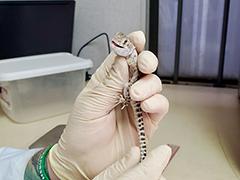Fresno, State and Federal Agencies partner to recover endangered lizard
Organization:
BLM Office:
Media Contact:
Fresno, Calif. – Officials at Fresno Chaffee Zoo, Fresno State University, Bureau of Land Management, California Department of Fish and Wildlife and U.S. Fish and Wildlife Service announce a joint conservation effort to recover the endangered blunt-nosed leopard lizard. As part of this effort, Fresno Chaffee Zoo has successfully hatched 19 lizards in a captive breeding program—a first for the species—with the long-term goal of releasing them to their native habitat.
“Each and every animal serves an important role in our ecosystem, so it’s imperative to conserve species in their natural habitats,” said Fresno Chaffee Zoo General Curator Lyn Myers. “These 19 individuals represent a chance to ensure that blunt-nosed leopard lizards will be around for generations to come. The work that we are doing and the knowledge gained will help blunt-nosed leopard lizards both at our Zoo and in their natural habitat.”
The blunt-nosed leopard lizard was listed as an endangered species at the state and federal level in the mid-1960s. Found only in central California, the lizard is in danger of extinction throughout its range. The species’ declines are directly associated with habitat loss, a continuing challenge.
For more than a decade, the Bureau of Land Management has been closely monitoring blunt-nosed leopard lizards on public lands it manages in the Panoche Hills, bordering the San Joaquin Valley. The BLM seasonally closes the Panoche Hills to vehicle access during mating season and designated it as an Area of Critical Environmental Concern. The Bureau has invested significant resources to document the population decline by employing innovative survey methods using scat to identify the DNA of individual lizards.
“The Bureau of Land Management is excited to see our commitment to the blunt-nosed leopard lizard move the needle towards recovery,” explains BLM Central Coast Field Office Wildlife Biology Program Lead Dr. Mike Westphal. “Collectively, we can do so much more together as partners to conserve this population and hopefully many other imperiled species in the future.”
To support the species’ recovery, the partners developed a captive breeding plan in late 2020. Between July 2020 and July 2021, six adult blunt-nosed leopard lizards were collected from Panoche Hills to serve as founders for a breeding program.
During the next five years, Fresno Chaffee Zoo, together with their agency partners, will continue the breeding effort to increase the population for eventual release in the Panoche Hills.
“This captive breeding program is essential for recovering the blunt-nosed leopard lizard in the Panoche Hills. By raising the lizards in a controlled environment, we can improve their chances of survival when they are released into the wild. The species is on a better path because of this collaboration,” said U.S. Fish and Wildlife Service’s Sacramento Fish and Wildlife Office Field Supervisor Michael Fris.
Successfully breeding this species for the first time in captivity has provided valuable data on and insight into the species, including the number of eggs female lizards lay per clutch, length of breeding season, and length of incubation period. Partners will use this information to project future breeding estimates and expectations. Each year, the partners hope to release young lizards back to the Panoche Hills.
The goal of this joint effort is the eventual re-creation of a self-sustaining population of blunt-nosed leopard lizards in the Panoche Hills. The partners have outlined a goal of more than 50 females whose ancestors were born on the plateau, successfully reproducing each year for three consecutive years. All released individuals will be monitored to assess their survival and further breeding in their natural habitat.
“This exciting partnership has rapidly responded to save a critically imperiled population of an endangered species. At the same time, we are also learning about important elements of the blunt-nosed leopard lizard’s life history which will assist in recovery efforts for the entire species. A wonderful benefit of this partnership is that residents of the San Joaquin Valley can learn about a rare and fascinating local California endemic species from Fresno Chaffee Zoo,” said California Department of Fish and Wildlife Regional Manager Julie Vance.
The breeding season for the blunt-nosed leopard lizard adult colony at Fresno Chaffee Zoo is over and will begin again in spring 2022. The partners are encouraged by this first batch of hatchlings, which confirm the agencies’ collaborative success and progress toward a thriving blunt-nosed leopard lizard population for future generations.
The BLM manages about 245 million acres of public land located primarily in 12 western states, including Alaska, on behalf of the American people. The BLM also administers 700 million acres of sub-surface mineral estate throughout the nation. Our mission is to sustain the health, diversity, and productivity of America’s public lands for the use and enjoyment of present and future generations.

